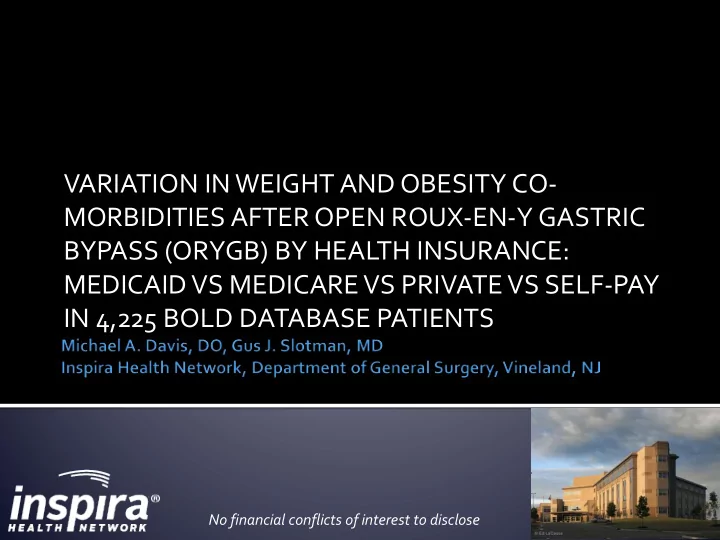

VARIATION IN WEIGHT AND OBESITY CO- MORBIDITIES AFTER OPEN ROUX-EN-Y GASTRIC BYPASS (ORYGB) BY HEALTH INSURANCE: MEDICAID VS MEDICARE VS PRIVATE VS SELF-PAY IN 4,225 BOLD DATABASE PATIENTS No financial conflicts of interest to disclose
Previous studies demonstrated variations in outcomes among different insurances following bariatric surgery. To identify variations by health insurance (Private, Self-Pay, Medicare & Medicaid) in weight loss and co-morbidity resolution in patients who have undergone ORYGB. Data from 4,225 surgery patients from Surgical Review Corporation’s BOLD data were analyzed retrospectively at pre-op, 2, 6, 12, 18 and 24 months 29 co-morbidities were analyzed utilizing ANOVA, pair-wise comparisons on the least square means of the ANOVA models Chi-squared was used for pair-wise comparisons for each arm versus each other arm, at each follow up interval.
Co-Morbidiites Self-Pay Private Medicare Medicaid 29 Co-Morbidities • grouped in 6 Lowest 24 3 1 0 Categories: Cardiopulmonary • Highest 2 0 11 16 Abdominal • Endocrine • Somatic • Weight & BMI lowest among Private patients through 6 months, but • Behavioral • did not vary significantly thereafter Weight/Weight • HTN lowest in Self-Pay up to 18 months, with Medicaid persisting at • Loss/BMI the highest rates Early (6 mos.) OSA resolution resolved best for Self -Pay, then • Private, but long term variance fades Abdominal hernia resulted most frequently in Medicaid through 24 • months at rates nearly double the other three groups Panniculitis found in Self-Pay nearly double the other groups by 24 • months (44.4% vs. Medicaid 19.5%, Medicare 18% & Private 10.3% p<0.01).
Private and Self-Pay patients benefitted more from ORYGB than did Medicaid or Medicare. Post-operatively, Private patients had the lowest rates of five weight-related co-morbidities and highest in none. Self-Pay were highest in three co-morbidities, but resolved 17 others to the lowest levels, comparatively. In contrast, Medicaid and Medicare were highest in 8 and 9 co- morbidities, respectively, and lowest in none. Our review of the literature reveals that these variations in outcomes following ORYGB have not been reported previously and are the significant findings of this study. This advance knowledge can provide surgeons with heightened index of suspicion for results and post-ORYGB problems that may facilitate optimal management of these fragile patients.
Obesity co-morbidities vary by health insurance status after ORYGB. Self-Pay insurance had best results. Private and Medicare were intermediate. Medicaid fared less well. Outcomes after ORYGB vary by health insurance. These findings may facilitate more individualized management of ORYGB patients.
Recommend
More recommend